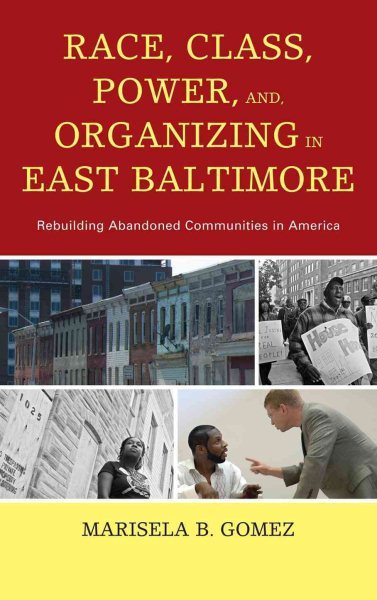Memory Against Forgetting: Marisela Gomez's book illuminates the history of the fight against displacement and dispossession in East Baltimore
Review by John Duda.
This review originally appeared on indyreader.org.
Let's start with a website. Visit ebdi.org and you'll find a glowing description of responsible urban development, of a large institution acting benevolently, even munificently, to lift up a troubled neighborhood, mired in generations of poverty, and bringing prosperity back to a decaying city. This is a good story, and one that postindustrial cities, clinging to their “anchor institutions,” are increasingly vocal in telling.
In Baltimore, however, this website and its reassuring story leaves something out: the real history of struggle, led by the residents of the Middle East neighborhood who have been fighting the East Baltimore Development Inc. (EBDI) for over a decade. These were the residents who learned that the Johns Hopkins Medical Institutions (JHMI), through its quasi-public proxy EBDI, would be taking their homes through eminent domain: one morning when they woke up to the story in the Baltimore Sun. These were the residents who refused to go quietly and agree that the public good would be served at the cost of uprooting their community, and who dared to fight back against the very powerful institutions who wanted to decide the future of the Middle East. And these are the residents whose story is told in Dr. Marisela Gomez's new book, Race, Class, Power, and Organizing in East Baltimore.
Dr. Gomez comes to this project as someone who fought with the neighborhood, accompanying the residents as a key organizer in SMEAC, the Save Middle East Action Committee, which, on a shoestring budget, reknitted the tattered fabric of what Dr. Gomez describes as an “abandoned neighborhood”—disinvested, marginalized, underserved, and ignored—and gave the residents a space to amplify their collective voice in opposition to the institutions which wanted to remake their neighborhood without them.

But she also comes to the history with the eyes of a clinician, bringing her professional training as a public health specialist to bear on the institution at which she received it. This is a book that's not just about the long story of EBDI,[1] its failure to engage the community in its vision for the neighborhood, and the history of the neighborhood organization that stood up to challenge the terms. It is a diagnosis of the health of a community, one that looks beyond the milestones of when a specific promise was made or broken, or when a specific protest was held or meeting convened, to capture what development-as-displacement does to a neighborhood; how the constant pressure of years of uncertainty, waiting for the bulldozers, or the stress of relocation, exhausts the community, puts its members at risk. The irony runs deeper than just a world-class hospital surrounded by entrenched urban poverty with all the negative health outcomes that brings: in Dr. Gomez's account, what emerges is the story of an institution whose own actions threaten the health of the community, from the unsafe practices of demolition to the long-term psychological and bodily consequences of what Mindy Fullilove has named “root shock.” If I have one problem with Race, Class, Power, and Organizing (besides its exorbitant and prohibitive hardcover price!), it's that the book's focus on the structural dimensions of the story in East Baltimore, the diagnosis of a rebuilding process gone awry, tends towards a voice which anonymizes both the heroes and the villains. Dr. Gomez's professionalism, her clinical voice, doesn't name names, which at times make the narrative thread hard to hold onto.
But it more than makes up for this in other respects. For social justice organizers in Baltimore and beyond, her careful and self-critical history of SMEAC will be invaluable: she tracks not just the processes and procedures of transparency, accountability, and direct democracy that enabled its best days as the voice of the neighborhood, but highlights the challenges and failures as well, like those moments when the organization did not live up to its mandate, or could not build the capacity to engage with development on the scale of a citywide coalition. And this organizational history is told alongside the history of the displacement of the residents of the Middle East, revealing the way a changing urban geography can both enable and suppress the capacity of residents to organize themselves.
Also invaluable is Dr. Gomez's insistence on placing the history of SMEAC and EBDI in a much larger historical context: the parallels she draws between the recent development initiative and the Broadway Redevelopment Project a half-century ago are almost uncanny, and sadly too familiar. Her account also highlights alternatives: like the history of the Gay Street I project, which redeveloped a section of East Baltimore without displacement and with extensive resident participation, or the numerous more contemporary efforts she details, from Oldtown and Sandtown-Winchester here in Baltimore, to projects like the Dudley Street Neighborhood Initiative in Boston, that fought back against blight and disinvestment in ways that empowered rather than removed existing residents.
Above all, the book insists on the primacy of listening. EBDI's greatest failure has perhaps been its inability to hear the concerns of residents, its refusal to take them seriously as equal stakeholders in the fate of the neighborhood. When, as Dr. Gomez documents, residents draw on generations of historical memory to characterize EBDI's master plan as “the Master's plan,” the correct response here is not to dismiss this out of hand and get back to work with technocratic designs for a sanitized community, but to take seriously the need for an anti-racist approach that understands the tragic persistence and continuity of white supremacy as a determining factor in the configuration of urban power relationships in the United States, and act accordingly.
A remarkable picture is included in Dr. Gomez's book, illustrating this key point. An EBDI official—a white man in a suit—stands over a seated African-American organizer from SMEAC. The EBDI official is pointing, lecturing the organizer, looming in his face. The organizer is responding, calmly, despite the violence implicit in the body language of the EBDI official, but the picture offers little guarantee that his words will be heard or taken seriously.

As EBDI attempts to rebrand the Middle East as “Beacon Park,” erasing the traces of dispossession and displacement, struggle and resistance, an account like Dr. Gomez's is critical. Without a doubt, development will continue in Baltimore, and given the need to rebuild its communities and create jobs for a postindustrial city, this isn't necessarily a bad thing. But, with Dr. Gomez and the residents of the Middle East whose story she tells, we should remember that “to remove a group of residents and then claim to have rebuilt the community is simply redevelopment of physical space. To rebuild a community with the participation of the historic residents, who provide direction in addressing the causes and the consequences of abandonment, is community transformation.”
--
1 One of the best resources for a comprehensive accounting of EBDI from the business perspective: its failures to deliver on its original vision of a biotech-driven economy in East Baltimore, and its turn towards a new master plan focused on amenities for a gentrified Middle East, remains the excellent series by Melody Simmons and Joan Jacobson in the Daily Record.

